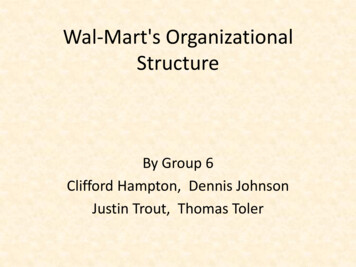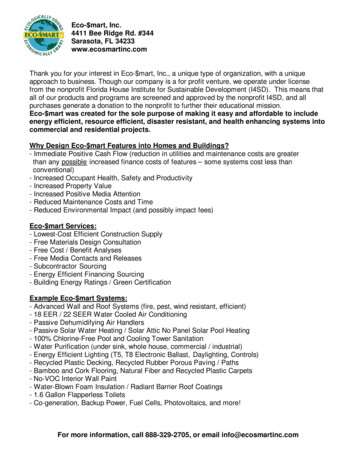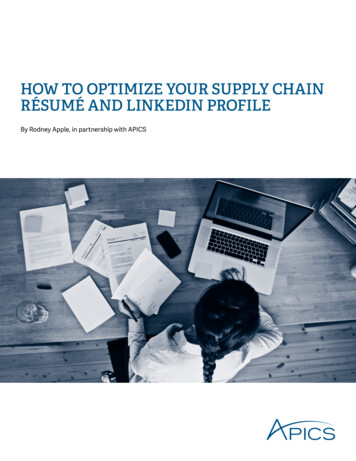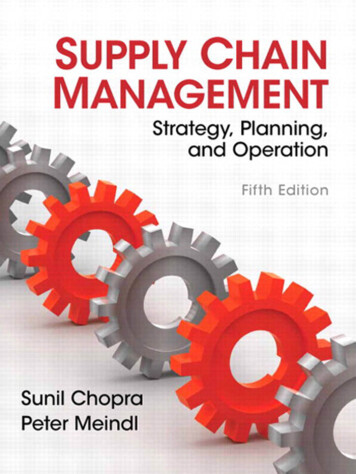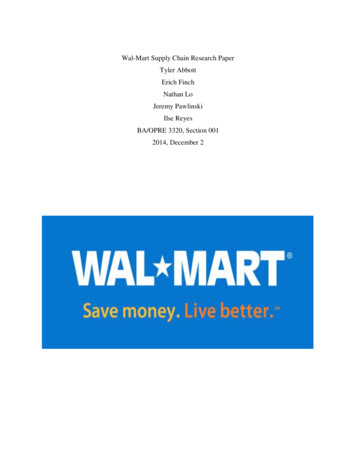
Transcription
Wal-Mart Supply Chain Research PaperTyler AbbottErich FinchNathan LoJeremy PawlinskiIlse ReyesBA/OPRE 3320, Section 0012014, December 2
Wal-Mart Supply Chain Research Paper1Table of ContentsCompany & Division . 2Vision/Mission . .2Company Structure.2Supply Chain Diagram . .3Customers 4Order Processing .5Procurement .6Inventory . 9Manufacturing 10Logistics Facilities Network .11Transportation Methods . 12Information Systems . 13Uniqueness . 14Competition 16Current/Future Challenges . .16Recommendations for Potential Improvement . 17Which team member did what part 18Bibliography .19
Wal-Mart Supply Chain Research Paper2Company & DivisionSam Walton opened the first Wal-Mart store in Roger, Arkansas in 1962. Walton wasdedicated to making a difference in the lives of valuable customers for a lifetime. “Sam Walton'svisionary leadership, along with generations of associates focused on helping customers andcommunities save money and live better (Walmart Corporate. Our History).” This rich heritagedefines who Wal-Mart is and what they do today. 52 years have passed and Wal-Mart hasexpanded to a global marketplace serving 26 countries, over 160 Distribution Centers and 17,000retail stores scattered throughout the US. From the beginning in 1962 to present day, Wal-Marthas grown into what is referred to today as one of the greatest Supply Chain Companies inexistence.Vision/MissionThe vision of Wal-Mart is to be the largest, most effective retail organization in theworld, and to offer a large assortment of quality products while providing efficient service.(Researchomatic, 2013) When thinking of Wal-Mart, the first thing that comes to mind is theyellow starburst and the flat baby blue bold letters. What does not grab the attention ofconsumers are how the products that are on the shelves make it to the stores. Wal-Mart hasimproved the system, and rewritten how the supply chain works for business of moving productsacross county and into retail stores. As a leader, they are continuously improving operations toreduce cost and pass the savings on to the consumer. Wal-Mart’s 2013 mission statement “Wesave people money so they can live better” (Wal-Mart, 2013) sums up their success in one shortphrase.Company StructureWal-Mart corporate structure is composed of three divisions: Wal-Mart Retail stores,Sam’s club, and Wal-Mart international. The company has several different store structures:Supercenters, Market Centers, Sam’s Club (discount center) and Wal-Mart international.Wal-Mart decided to extend the organizations global presence in 1991. Outside the United StatesWal-Mart operates in 26 countries. It considered the fastest growing division of the business.Sam’s club is a chain of warehouse that sells groceries and merchandise in bulk. Sam’s club isthe only division of Wal-Mart that requires a membership. There is a benefit Wal-Mart has in thedesign of their organizational structure. They are able to specify the market and satisfy the
Wal-Mart Supply Chain Research Paper3customers demand for products; Wal-Mart is able to change business practices within the areasthat they operate.Supply Chain tributionCenters(160)Retail Stores(Over 17,000)End Customer245 million a weekVendors(Over 4,000.I.e. Proctor andGamble, PepsiCo)Informationand MoneyFlow
Wal-Mart Supply Chain Research Paper4The Wal-Mart Supply Chain is a technologically based system. It is very in depth, andintellectually guarded. The proficiency that Wal-Mart has, and the volume of output it producesfrom their manufacturing facilities and vendors is truly astonishing. At the start of their supplychain is their raw material suppliers who send raw materials to Wal-Mart’s manufacturingfacilities in China. The transportation here is under a third party logistics company. From here,the manufactured goods are shipped overseas via their third party logistic company towarehouses in the United States (University Alliance, 2014). These warehouses then ship goodsto Distribution Centers (DC). In total Wal-Mart has 160 distribution centers that are separated bygeographical locations in the US to feed the retail stores through cross docking. The time spentin the warehouses is less than 48 hours (University Alliance, 2014). Wal-Mart’s emergingEcommerce market that serves 11 countries outside the U.S. views the available inventory in theDCs and ships the desired product to the door of the customer instead of going to the retailstores. There is an option if the customer chooses to ship their product to the store. With over17,000 retail stores to choose from this is a viable option. Vendors work in close communicationwith retail stores, because some vendors actually go into the retail establishment or ship productto the retail stores when product is demanded and stock the shelves. From the DCs to the Retailstores, Wal-Mart employs over 6,000 private fleet drivers to deliver products to the retailestablishments (University Aliance, 2014). The desired product is then picked from the shelf, andpurchased by the customer. The information and money moving up the supply chain will bediscussed in the order-processing segment.CustomersWal-Mart has customers that include all cultures, races, age groups, and genders. Wal-Martsare generally accommodating and targeting lower income level geographical location, since theyhave lower prices than competition. There is no definition of whom a Wal-Mart customer is.Wal-Mart is known for having low prices guaranteed and this is what brings in the abundance ofmore than 245 million customers per week. These customers visit more than 11,000 Wal-Martlocations in the US, over 6,100 retail locations located in 27 countries outside of the US, and 11countries served via Wal-Mart ’s Ecommerce business (Wal-Mart Inc. 2014)
Wal-Mart Supply Chain Research Paper5Order ProcessingWal-Mart’s order processing is fulfilled by an integrated technology imbedded in theproducts taken off the shelf by the customers. As the product is scanned using the SKUS theinventory level on the Point of Sales System drops and is connected to a system called Retail linkthat takes the SKUs scanned and sends them up to Wal-Mart’s satellite system giving vendorsand suppliers real-time data. This data tells vendors what products are being purchased, at whatquantity, and when to restock the stores levels. This is an advantage to vendors so that they knowwhat products to continue supplying and what products to pull form the shelves. The orders arethen processed for vendors and Wal-Mart acts as the middleman just reserving the shelving spacefor the vendors and getting the percentage markup agreed upon in contracts. With the orderprocessing, Wal-Mart corporate offices are also able to receive the data and know what productsto purchase more of in bulk, to keep costs down. Collaborative planning, and forecasting andreplenishment also aids in order process and is a vital part of Wal-Mart’s order processing byforecasting data from the Retail link and Satellite data (Gilmore, 2012).Customer service metrics are received by customer feedback upon returns. The servicemetrics can be determined by the number of returns made to the store, for what reason. This datacan be implemented into the system to further grow the customer service department. “In 2008Walmart surveyed their customers and found out they disliked a cluttered store with overstockedshelves, pallets of product and heavily stocked and promoted items at the end of the aisles (endcap displays). They remodeled their stores and customer satisfaction levels increased (ShepHykan).”
Wal-Mart Supply Chain Research Paper6ProcurementWal-Mart’s procurement practices have gone through multiple changes over the yearsand an aggressive change came back in 2010 when Wal-Mart decided to overhaul its globalpurchasing practices. “Wal-Mart’s new global sourcing strategy involves the creation of GlobalMerchandising Centers, a change in leadership and structure, and a strategic alliance with Li &Fung, a global sourcing organization” (Wal-Mart 2010). The Global Merchandising centers willbe in areas that already specialize in their respective products. For example, England will carry alot of the general goods and clothing; while Mexico’s global merchandising center will houseproduce. The global merchandising centers will help Wal-Mart manage their suppliers better (noabundance of third party logistics companies and plethora of suppliers to have to manage) thusleading to cost savings. Not only cost savings will come from cutting out the middleman, theycan also get more of VIP relationship with their merchandisers, as the Supply Times puts it “Thelogic is simple: by eliminating layers of middlemen, Wal-Mart can detail what it wants andmanufacturers align themselves accordingly.” (Supply Times, 2010).Wal-Mart decided to all but eliminate using third party logistics companies to let themgain more of a competitive edge and add more to their profit baseline. “Mr. Castro-Wright hasestimated that shifting to direct purchasing could reduce costs by 5-15 per cent across the supplychain within five years – suggesting potential savings of 4bn- 12bn if the retailer were to meetits long-term goal of shifting to sourcing about 80 per cent of purchases directly” (Birchall2010). Wal-Mart is a massive firm and has the financial prowess and logistical capability tomake such a drastic move to essentially cut out the middleman. This shift to direct purchasingcan help save them billions as well as give them a little more control over their suppliers, but it isnot entirely a win-lose relationship. Proctor and Gamble have said in the past that simply havingthe exposure inside the retail behemoth is worth the cost of business with them. These suppliersdo not make much of a profit when they supply goods to Wal-Mart, but they make enough tokeep the lights on at their facilities, but the brand recognition gained by collaborating with WalMart is worth it.
Wal-Mart Supply Chain Research Paper7(ISE, 2013)As mentioned above, Wal-Mart has tremendous buying power, Procter and Gamblemakes little to no money selling their goods to Wal-Mart, but having their products on theshelves of the retail giant makes it worth it. In the diagram above are Wal-Mart’s suppliers andthe percentage of their business that flows through Wal-Mart retail outlets. The reader can seethese companies are extremely dependent on Wal-Mart. The more Wal-Mart has thesecompanies eating out of the palm of their hand, the more buying power they have during thebuying process.
Wal-Mart Supply Chain Research Paper8They have also cut out a lot of waste with the implementation of their Electronic DataInterchange practices. Wal-Mart was ahead of the game back in the 1980s when they “purchaseda satellite and by 1988 held the largest privately owned communications network in thecountry to handle Electronic Data Interchange (EDI)” (Khaade, Lovas, 2010). By getting aheadof their competitors and implementing Electronic Data Interchange, Wal-Mart was and still isable to run a remarkably efficient supply chain. Now their suppliers can just log into Wal-Mart’sEDI system and check to see if they need to re-stock their products; that way the suppliers do notneed to spend all that capital on forecasting.Wal-Mart has over 57,000 suppliers in the US alone (Schmitt, 2009). “Wal-Martgenerally starts out smaller suppliers in a local market, delivering goods to up to 50 stores, as atest run. If the supplier provides a high-selling product and proves reliable, it might beconsidered for national distribution” (Schmitt, 2009). That previous quote from the BusinessWeek article shows how Wal-Mart is committed to building up small suppliers, but only if thesuppliers show they have the ability to grow. Wal-Mart has a tremendous amount of buyingpower; this allows them to be very picky when it comes to supplier selection. With this powerthey have encouraged their suppliers to lower their prices and become more eco-friendly, theyhave trended toward a green supply chain in recent years (this offers tax breaks from thegovernment and also helps out the environment) for benefits and to also become known as amore sustainable business.Wal-Mart pays its suppliers “within 30 to 45 days” after receipt of purchase order(Schmitt, 2009). The basic way that a supplier becomes a Wal-Mart supplier is for them tocomplete a series of steps. These steps include evaluate their own company to see if they arecapable to become a Wal-Mart supplier, ensure their company has a federal tax number, ensuretheir company has a Universal Product Code membership number, acquire a Dunn & Bradstreetnumber if they have none, ready picture and product information of your product, then begininitiation of product submission. If their product passes all those steps, the supplier is invited toWal-Mart’s headquarters in Bentonville Arkansas to pitch their product, within a week or so ofthe pitch Wal-Mart will make its final decision on the supplier to decide if they want to workwith them or not (Wal-Mart .com, 2014).
Wal-Mart Supply Chain Research Paper9InventoryWal-Mart currently has a large amount of inventory on hand; due to this fact, Wal-Martdecided to increase capital expenses that le
design of their organizational structure. They are able to specify the market and satisfy the . Wal-Mart Supply Chain Research Paper 3 customers demand for products; Wal-Mart is able to change business practices within the areas that they operate. Supply Chain Diagram I.e. Proctor and Suppliers Manufacturing Facilities Physical Product Flow Warehouses Ecommerce Distribution (Checks .
